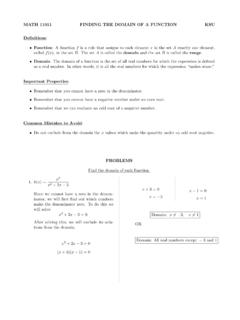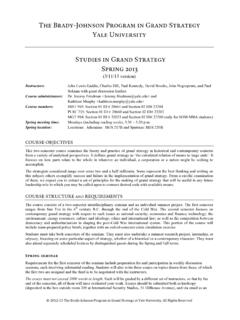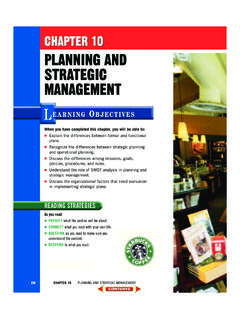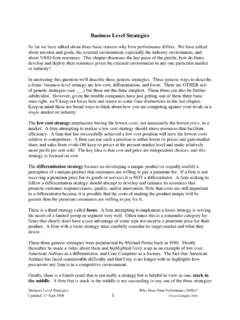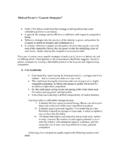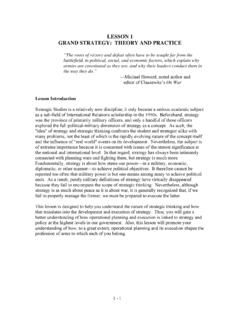Transcription of Chapter 7 Acquisitions and Restructuring Strategies
1 Slide 1 Copyright 2004 South-WesternAll rights slides by:R. Dennis MiddlemistColorado State UniversityChapter 7 Chapter 7 Chapter 7 Acquisitions and Restructuring StrategiesSlide 2 Copyright 2004 South-Western. All rights reserved. 7 2 Types of Corporate & grand StrategiesConsortiaConcentrated GrowthMarket DevelopmentProduct DevelopmentInnovationHorizontal IntegrationVertical IntegrationConcentric DiversificationConglomerate DiversificationTurnaroundDivestitureLiqu idationBankruptcyJoint VenturesStrategic AlliancesSlide 3 Copyright 2004 South-Western. All rights reserved. 7 3 Mergers, Acquisitions , and Takeovers: What are the Differences? Merger A strategy through which two firms agree to integrate their operations on a relatively co-equal basis acquisition A strategy through which one firm buys a controlling, or 100% interest in another firm with the intent of making the acquired firm a subsidiary business within its portfolio Takeover A special type of acquisition when the target firm did not solicit the acquiring firm s bid for outright ownershipSlide 4 Copyright 2004 South-Western.
2 All rights reserved. 7 4 AcquisitionsCost new product development/increased speed to marketIncreased diversificationIncreased market powerAvoiding excessive competitionOvercoming entry barriersLearning and developing new capabilitiesLower risk compared to developing new productsReasons for Acquisitions and Problems in Achieving SuccessAdapted from Figure from Figure 5 Copyright 2004 South-Western. All rights reserved. 7 5 Acquisitions : Increased Market Power Factors increasing market power When there is the ability to sell goods or services above competitive levels When costs of primary or support activities are below those of competitors When a firm s size, resources and capabilities gives it a superior ability to compete Acquisitions intended to increase market power are subject to: Regulatory review Analysis by financial marketsSlide 6 Copyright 2004 South-Western.
3 All rights reserved. 7 6 Acquisitions : Increased Market Power (cont d) Market power is increased by: Horizontal Acquisitions Vertical Acquisitions Related acquisitionsvConcentric diversificationSlide 7 Copyright 2004 South-Western. All rights reserved. 7 7 Strategies of Horizontal and Vertical Integration Horizontal integration Based on growth via acquisitionof one or more similar firms operating at the same stage of the production-marketing chain Involves eliminating competitors, providing acquiring firm with access to new markets Vertical integration Involves acquiring firmsvTo supply acquiring firm with inputs -backward integrationorvAre customers for firm s outputs -forward integrationSlide 8 Copyright 2004 South-Western.
4 All rights reserved. 7 8 Acquisitions or mergers of suppliers or customer businesses arevertical integrationsvertical integrationsAcquisitions or mergers of competing businesses arehorizontal integrationshorizontal integrationsTextile producerShirt manufacturerClothing storeTextile producerShirt manufacturerClothing storeVertical and Horizontal IntegrationsSlide 9 Copyright 2004 South-Western. All rights reserved. 7 9 Acquisitions : Overcoming Entry Barriers Factors associated with the market or with the firms currently operating in it that increase the expense and difficulty faced by new ventures trying to enter that market Economies of scale Differentiated products Cross-Border AcquisitionsSlide 10 Copyright 2004 South-Western.
5 All rights reserved. 7 10 Acquisitions : Cost of New-Product Development and Increased Speed to Market Internal development of new products is often perceived as high-risk activity Acquisitions allow a firm to gain access to new and current products that are new to the firm Returns are more predictable because of the acquired firms experience with the productsSlide 11 Copyright 2004 South-Western. All rights reserved. 7 11 Acquisitions : Lower Risk Compared to Developing New Products An acquisition s outcomes can be estimated more easily and accurately than the outcomes of an internal product development process Managers may view Acquisitions as lowering riskSlide 12 Copyright 2004 South-Western.
6 All rights reserved. 7 12 AcquisitionsReasons for Acquisitions and Problems in Achieving SuccessAdapted from Figure from Figure difficultiesInadequate evaluation of targetLarge or extraordinary debtInability to achieve synergyToo much diversificationManagers overly focused on acquisitionsToo largeSlide 13 Copyright 2004 South-Western. All rights reserved. 7 13 Table of Successful AcquisitionsSlide 14 Copyright 2004 South-Western. All rights reserved. 7 14 Restructuring A strategy through which a firm changes its set of businesses or financial structure Failure of an acquisition strategy often precedes a Restructuring strategy Restructuring may occur because of changes in the external or internal environments Restructuring Strategies : Downsizing Downscoping Leveraged buyoutsSlide 15 Copyright 2004 South-Western.
7 All rights reserved. 7 15 Types of Restructuring : Downsizing A reduction in the number of a firm s employees and sometimes in the number of its operating units May or may not change the composition of businesses in the company s portfolio Typical reasons for downsizing: Expectation of improved profitability from cost reductions Desire or necessity for more efficient operationsSlide 16 Copyright 2004 South-Western. All rights reserved. 7 16 Types of Restructuring : Downscoping A divestiture, spin-off or other means of eliminating businesses unrelated to a firm s core businesses A set of actions that causes a firm to strategically refocus on its core businesses May be accompanied by downsizing, but not eliminating key employees from its primary businesses Firm can be more effectively managed by the top management teamSlide 17 Copyright 2004 South-Western.
8 All rights reserved. 7 17 Divestiture and Liquidation Strategies Divestiture strategy Involves selling a firm or a major component of a firm Reasons for divestiturevPartial mismatches between acquired firm and parent firmvCorporate financial needsvGovernment antitrust action Liquidation strategy Involves selling parts of a firm, usually for its tangible asset value and not as a going concernSlide 18 Copyright 2004 South-Western. All rights reserved. 7 18 The Strategy of Bankruptcy Two approaches Liquidation-Involves complete distribution of a firm s assets to creditors, most of whom receive a small fraction of amount owed Reorganization-Involves creditors temporarily freezing their claims while a firm reorganizes and rebuilds its operations more profitably Advantageof a reorganizationbankruptcy Proactive optionoffering maximum repayment of a firm s debt in the future if a recovery strategy is successful Slide 19 Copyright 2004 South-Western.
9 All rights reserved. 7 19 Restructuring : Leveraged Buyouts A Restructuring strategy whereby a party buys all of a firm s assets in order to take the firm private Significant amounts of debt are usually incurred to finance the buyout Can correct for managerial mistakes Managers making decisions that serve their own interests rather than those of shareholders Can facilitate entrepreneurial efforts and strategic growthSlide 20 Copyright 2004 South-Western. All rights reserved. 7 20 Restructuring and OutcomesAdapted from Figure from Figure 21 Copyright 2004 South-Western. All rights reserved. 7 21 Declining sales or marginsImminent bankruptcyLowHighCost reductionAsset reductionEfficiency maintenanceEntrepreneurial reconfigurationStabilityRecoveryInternal factorsExternal factorsTurnaround situationTurnaround responseCauseSeverityRetrenchment phaseRecovery phase(operating)(strategic)A Model of the Turnaround Process Copyright 2004 South-Western.
10 All rights reserved. 7 22 grand Strategy Selection MatrixOvercome weaknessesMaximize strengthsExternal ( acquisition or merger for resource capability)Internal (redirected resources within the firm)Turnaround orretrenchmentDivestitureLiquidationVert ical integrationConglomerate diversificationConcentrated growthMarket developmentProduct developmentInnovationHorizontal integrationConcentric diversificationJoint ventureIIIIVIII Copyright 2004 South-Western. All rights reserved. 7 23 Model of grand Strategy ClustersRapid market growthSlow market growthWeak competitive positionStrong competitive position1. Concentrated growth2. Vertical integration3. Concentric diversification1. Reformulation of concentrated growth2.



